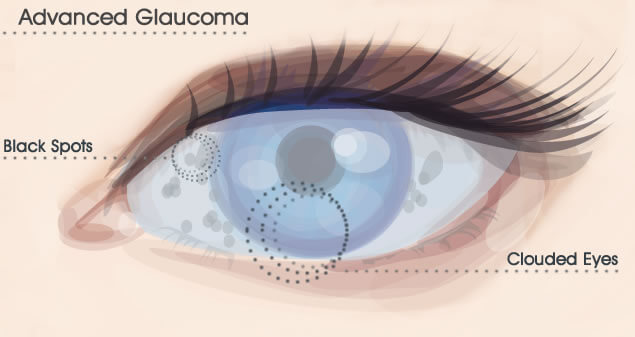
Glaucoma is a group of eye diseases that affect the optic nerve, the nerve which communicates vision from the eye to the brain, and causes vision loss. The pressure inside the eye is called intraocular pressure, or IOP. An increase in intraocular pressure is the most common sign of glaucoma. A normal IOP can range from 10-21 mm Hg and is the most important risk factor to consider while maintaining eye health in order to catch early stages of glaucoma.
A small space at the front of the eye is called the anterior chamber. Clear fluid known as the aqueous humor flows in and out of the anterior chamber to nourish the tissues. When glaucoma occurs, the fluid drains more slowly, and as the fluid builds up, the intraocular pressure rises in the eye. This uncontrolled pressure results in damage to the optic nerve. Half of the people with glaucoma are usually not aware they have developed this condition until they experience a severe vision loss.
| Factors Which Increase the Risk of Developing Glaucoma |
| Elevated IOP |
| Family history |
| Ethnic background |
| Smoking |
| Old age |

Most people with glaucoma do not notice symptoms until they begin to have significant vision loss. Small blind spots develop, usually in the peripheral or side vision. Blindness from glaucoma is a result of the optic nerve being totally destroyed. Sudden increases in IOP, especially with acute angle-closure glaucoma, may include blurred vision, halos around lights, severe eye pain, headache, abdominal pain, nausea, and vomiting.

Treatment is designed to lower the IOP by reducing production or increase outflow of the aqueous humor. Depending on the type of glaucoma, medications or surgery are used.
There are various kinds of medications used to control the IOP, such as pressure eye drops. Betagan, Betimol, Betoptic-S, Istalol, Timoptic and Timoptic XE, Lumigan, Xalatan, Alphagan, Azopt, Trusopt, Travatan, Combigan, and Cosopt are the most commonly used medications for maintaining good intraocular pressures. In more severe cases, Diamox is administered by mouth.
In some cases, surgery may need to be performed because the right combination of medications is not effective.
| Preventative Measures Following Surgery | |
| Medications | Know when and how they should be taken. |
| Signs and symptoms | Know what symptoms to anticipate that may suggest medication failure, side effects, or other problems. |
| Limitations | Know what activities you must refrain from and for how long. |
| Follow-up exam | Know when to set up an appointment with your doctor for your follow-up exam and if tests need to be performed. |
In most cases, the best prevention for glaucoma is early detection. If detected early, vision loss and blindness may be prevented. Anyone older than 20 years of age should have a glaucoma screening. Periodic eye exams are recommended for the rest of your life to help prevent and identify glaucoma, especially if you have certain risk factors, e.g. having a family history of glaucoma.
Although glaucoma cannot be cured, it can be controlled. People with glaucoma need to have regular eye examinations and usually need to continue treatment for the rest of their lives.
At Miami Eye Center, Dr. Joseph Selem will meet with you during your private consultation to assess your individual situation. Dr. Selem can help you decide which Glaucoma treatment in Miami is right for you. See the beauty in yourself and the world around you in crisp, clear detail today! Request an appointment online or call Dr. Joseph Selem and the staff at Miami Eye Center at 305-444-0221 to schedule your private consultation.
